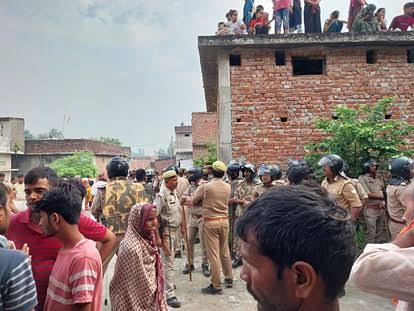BAHRAICH, UTTAR PRADESH – The small town of Bahraich has become the epicenter of communal violence following a tragic incident during the Durga idol immersion procession, leading to the death of a 22-year-old man and sparking widespread protests and demands for justice. The incident, which occurred on the evening of October 13, 2024, has not only shaken the local community but has also drawn the attention of state officials and the Chief Minister, Yogi Adityanath, who has promised strict action against the perpetrators.
The day started with the traditional immersion of Durga idols, a significant event during the Navratri festival, celebrated with great fervor across India. However, in Bahraich’s Mahsi area, what should have been a solemn and joyful procession turned into a scene of chaos and violence. The trouble began when a group of Muslim men demanded the music from the procession be turned off as it passed through what they claimed was a “Muslim Area”. This request, according to eyewitnesses, was met with resistance, leading to an escalation where stones were pelted, and gunfire erupted, resulting in the death of Ram Gopal Mishra, a young man who was part of the procession.
The aftermath saw local residents, incensed by the killing, take to the streets in protest. Shops were vandalized, vehicles set ablaze, and the situation deteriorated rapidly, with the police having to resort to lathi charges and tear gas to control the crowd. The Bahraich-Sitapur highway was blocked, further intensifying the chaos. In response to the violence, the local administration suspended internet services in an attempt to quell the spread of misinformation and curb further escalation.
Chief Minister Yogi Adityanath, taking swift notice of the situation, announced that those responsible for the violence would face stringent legal action. “Safety is guaranteed to all, but instructions have been given to identify the rioters and those whose negligence led to the incident, and take strict action against them,” he stated, emphasizing the government’s commitment to maintaining law and order. The police, under heavy scrutiny, detained around 30 people in connection with the violence, with one individual, identified as Salman, being specifically named in an FIR for allegedly firing at the procession.
The police’s actions included route marches and the use of drones for surveillance, aiming to maintain peace and identify the culprits. This incident has reignited debates on communal harmony, with various political and social groups weighing in. The Bharatiya Janata Party (BJP) government swiftly handled the situation, especially given the Uttar Pradesh’s history of communal tensions during religious processions. Critics though argue that such incidents reflect deeper social divides that need addressing beyond mere law enforcement.
On the ground, the community of Bahraich is in a state of shock and mourning. Ram Gopal Mishra’s death has left a void in his family, who, along with the community, demanded justice before agreeing to perform his last rites. The local administration, in an effort to restore calm, engaged with religious leaders to ensure the immersion processions could continue in peace, highlighting the importance of dialogue in such sensitive times.
The violence in Bahraich serves as a stark reminder of the fragile balance between religious freedoms and communal harmony in India. While the state government has promised action, the broader challenge lies in fostering an environment where such processions, integral to the cultural fabric of the region, do not become flashpoints for conflict. This incident, while localized, has broader implications for how religious processions are managed across India, suggesting a need for community dialogues, better policing strategies, and perhaps, a deeper introspection on communal relations. The question of “Muslim Areas” also need to be addressed, when every inch of India belongs to all Indians and there cannot be separate “Muslim Areas” within Indian territory
As Bahraich slowly tries to return to normalcy, with additional police forces deployed and the administration working to restore public trust, the incident remains a grim reminder of the challenges faced in maintaining social harmony in a diverse, yet divided society. The path to healing will require not just justice for the victims but also a concerted effort towards understanding, tolerance, and mutual respect among communities.



